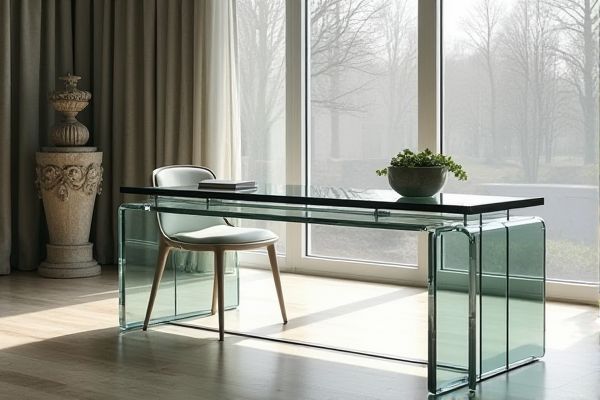
Acrylic desks offer lightweight durability and resistance to shattering, making them ideal for homes or offices requiring a modern, sleek look without heavy maintenance, while glass desks provide a more elegant and transparent aesthetic with greater weight and sturdiness but require careful handling and regular cleaning to maintain their shine. Explore the rest of the article to find out which desk material best suits Your workspace needs.
Table of Comparison
| Feature | Acrylic Desk | Glass Desk |
|---|---|---|
| Durability | Impact-resistant, less prone to shattering | Tempered glass is strong but can break on heavy impact |
| Weight | Lightweight and easy to move | Heavier, less portable |
| Appearance | Clear or tinted, slightly plastic look | Elegant, transparent, modern aesthetic |
| Maintenance | Scratch-prone, requires gentle cleaning | Easy to clean, fingerprint prone |
| Cost | Generally cheaper | Typically more expensive |
| Environmental Impact | Less sustainable, derived from plastic | Recyclable, more eco-friendly |
Introduction: Acrylic Desk vs Glass Desk
Acrylic desks offer lightweight durability and resistance to shattering, making them ideal for flexible, modern office setups. Glass desks provide a sleek, elegant appearance with high scratch resistance and easy maintenance but tend to be heavier and more fragile. Choosing between acrylic and glass desks depends on priorities like safety, aesthetics, and long-term durability for the workspace.
Material Overview: Acrylic and Glass
Acrylic desks feature a lightweight, shatter-resistant material made from polymethyl methacrylate (PMMA), offering durability and a modern aesthetic with greater flexibility in design and color options. Glass desks are crafted from tempered or laminated glass, providing a sleek, transparent surface that resists scratches and heat but is heavier and more fragile compared to acrylic. Your choice depends on whether you prioritize acrylic's impact resistance and versatility or glass's premium clarity and classic elegance.
Durability and Strength Comparison
Acrylic desks offer high impact resistance and excellent shatterproof qualities, making them more durable against everyday bumps and drops compared to glass desks. Glass desks, particularly those made with tempered or laminated glass, provide superior scratch resistance but are more prone to cracking or shattering under heavy impact. Both materials vary in weight tolerance, with acrylic generally supporting lighter loads while glass desks handle heavier weights more securely due to their rigidity.
Aesthetic Appeal: Modern vs Classic Looks
Acrylic desks provide a sleek, modern aesthetic with their transparent, lightweight design that complements contemporary interiors and open spaces. Glass desks convey a classic, timeless elegance, offering a polished and reflective surface that enhances traditional and sophisticated office settings. Both materials showcase minimalist beauty, but acrylic favors cutting-edge style while glass emphasizes enduring grace.
Weight and Portability
Acrylic desks are significantly lighter than glass desks, making them easier to move and reposition within a workspace. Their lightweight nature enhances portability, ideal for dynamic office setups or home offices requiring frequent rearrangement. Glass desks, although sturdier and often heavier, offer limited portability due to their weight and risk of damage during transport.
Safety Features and Breakage Risks
Acrylic desks offer enhanced safety due to their shatter-resistant material, reducing the risk of sharp injuries compared to glass desks, which can break into sharp shards upon impact. Glass desks, especially those made with tempered glass, provide improved durability but still carry a higher risk of breakage under heavy stress or sudden impact. Acrylic's flexibility and resistance to cracking make it a safer option for environments where breakage risk is a primary concern.
Maintenance and Cleaning Requirements
Acrylic desks require gentle cleaning with mild soap and a soft cloth to avoid scratches, while glass desks can be cleaned more aggressively using glass cleaners without damage. Acrylic surfaces tend to attract dust and fingerprints more easily than glass, necessitating more frequent maintenance for a clear appearance. Your choice depends on whether you prefer easier stain resistance or less frequent upkeep.
Cost Analysis: Budget Considerations
Acrylic desks typically cost less than glass desks, making them a budget-friendly option for those seeking modern aesthetics without a high price tag. Glass desks, especially tempered or designer varieties, tend to be more expensive due to material quality and manufacturing processes. When considering cost, acrylic offers durability and affordability, while glass provides a higher-end look but at an increased investment.
Environmental Impact and Sustainability
Acrylic desks typically have a higher environmental impact due to their petroleum-based production process and limited recyclability compared to glass desks, which are made from abundant natural materials and are more easily recycled. Glass desks contribute to sustainability through their durability and potential for reuse or recycling at the end of their lifecycle. Choosing your desk with sustainability in mind can significantly reduce your ecological footprint by favoring materials with lower environmental costs and better disposal options.
Choosing the Right Desk for Your Space
Acrylic desks offer lightweight durability with high impact resistance, making them ideal for versatile and modern workspaces, while glass desks provide a sleek, elegant appearance and easy maintenance but can be heavier and more fragile. Your choice depends on balancing practicality and design preference, considering factors like room size, aesthetic compatibility, and usage frequency. Selecting the right desk enhances both functionality and style in your workspace.
 homyna.com
homyna.com